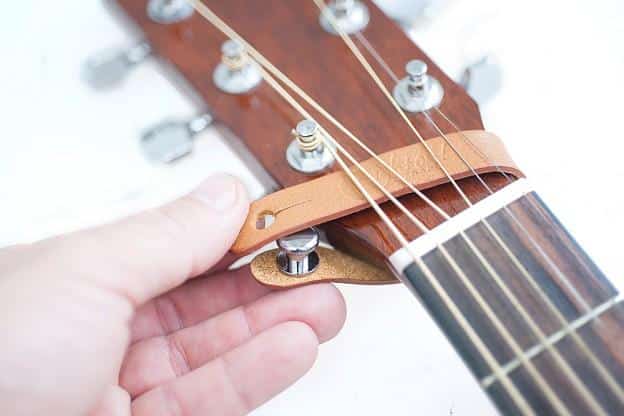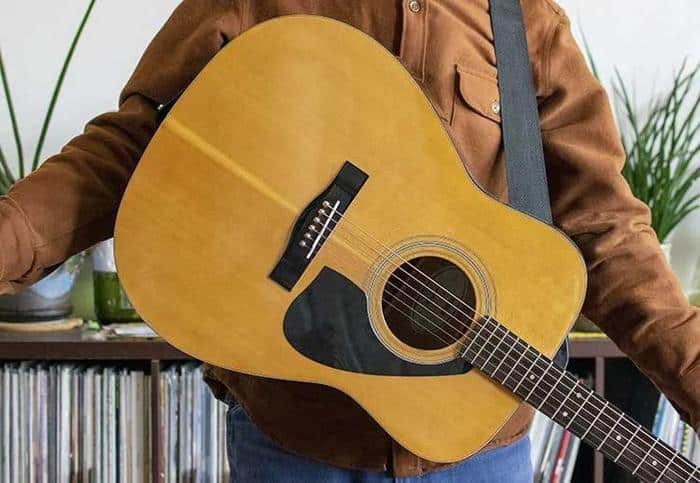So there I was, a seasoned engineer turned guitar craftsman, about to perform my first live gig armed with the first guitar I’d ever constructed. I was brimming with adrenaline, anticipation, and the unforeseen discomfort of an ineffectively designed guitar neck strap. That nerve-racking experience drastically altered my perception of this simple supporting accessory. How so, you ask? Well, let’s take this journey together.
Or perhaps, consider this – statistics suggest that over 60% of guitar-related injuries are caused by improper handling and inadequate support. Shocked? There’s more, and it’s directly linked to the topic at hand, the humble guitar neck strap.
Allow me to make a seemingly audacious claim – your guitar neck strap holds as much significance as the six strings that resonate to create the beautiful symphony of notes you play. Intrigued by this bold statement? Hang on, as I will soon unveil the facts behind this claim.
In this comprehensive guide, I will walk you through various guitar strap options, focusing on the potential of neck straps for ergonomic guitar playing. As someone who has straddled the worlds of engineering and guitar craftsmanship, I’ve learned the delicate dance of balancing comfort, safety, and performance. Let’s start this symphony, shall we?
Understanding Types of Guitar Neck Straps

In my years as a luthier, I’ve always been intrigued by how every piece of a guitar can affect the overall experience of playing for the musician. But one piece that we often overlook is the guitar straps. Throughout my journey in lutherie, I’ve experimented with different types of guitar straps—from leather to nylon and more. I’ve learned that the type of strap you choose can greatly impact both your performance and comfort.
Interestingly, the material of your guitar strap could make or break your performance. Let’s find out how.
While my trials and errors have introduced me to a wide array of guitar straps, the classic leather neck strap always stands out. A good quality leather guitar strap offers unparalleled durability and rigidity. Known for its ruggedness, leather straps effectively bear the weight of the guitar and stand the test of time. The comfort it provides to your shoulder while you play is unmatched.
However, no conversation about guitar straps would be complete without mentioning the nylon straps. Lightweight, flexible, and budget-friendly, these are the go-to choice for many beginners. The simplicity of their design allows broad strap compatibility with different guitar models. And yet, their plastic feel might not suit everyone’s preference.
Leather or nylon, when choosing a guitar strap, it’s important to consider both the balance and comfort it will provide while playing. Both can be fantastic options, depending on your needs and the type of music you play. For instance, jazz players inclined towards a softer sound might prefer the comfort and elegance of a leather strap. While for the rockers putting on an energetic show, a rugged nylon strap might provide a better balance and freedom.
The strap you choose is a reflection of not just your style, but your commitment to the craft. It’s these nuances, these small, seemingly insignificant choices that elevate an average performance to a memorable one. Remember, at the end of the day, a strap that feels good around your neck and supports your guitar right is the perfect pick for you.
Remember, there’s no right or wrong choice. What matters is what’s best suited for you- after all, a guitar strap is more than a mere accessory, it’s an extension of the player and the music they play.
Compatibility and Attachment
Attaching Straps for Different Guitars

I’d always been drawn to guitar modification. My fascination grew from an early exploration of adapting guitar straps to a multitude of instruments. It has since morphed into a keen understanding of the optimal techniques associated with attaching guitar straps, grounding me in a broad field of expertise.
The versatility of guitar straps truly shines when we talk about its compatibility and attachment. Understanding your guitar’s build makes a remarkable difference. Not all guitars are the same, and inevitably, the way straps attach will differ among varying models. Thus, strap compatibility and attachment become essential.
Some guitars have only one strap button at the bottom. For these, you’ll obviously have to attach the other end of the strap to the headstock, just behind the nut. Meanwhile, guitars with two strap buttons require a different approach. One end of the strap attaches to the bottom button, while the other fastens to the top button, usually located on the body behind the neck.
Ensuring a suitable match between strap and guitar isn’t a mere aesthetics matter; it’s an enormous contributor to playability and comfort. Correctly attaching your guitar strap can transform your next jam session or stage performance. Even when practicing at home, a well-attached guitar strap will enhance your playing experience and prevent any undue strain.
As we delve further into the topic, we’ll explore diverse methods of attaching straps—each with their unique benefits and implications.
Attaching to Headstock versus Body

As we delve deeper into ‘Compatibility and Attachment’, an essential factor emerges: the choice between tying a guitar strap to the headstock versus attaching it to the body. Over the years, I’ve developed an informed perspective through my in-depth analysis of guitar acoustics and engineering.
Each method has its merits and drawbacks; the optimal choice depends on the unique characteristics of your guitar and playing style. For instance, tying the guitar strap to the headstock could deliver a unique aesthetic appeal and, for some instruments, a more balanced weight distribution. However, this might put undue stress on the headstock, affecting guitar longevity.
Conversely, attaching the strap to the body is generally easier and more secure, minimizing risks of accidental drops. Yet, it might make certain playing positions less comfortable.
The key is understanding your instrument’s specifications and your comfort requirements so that you choose the most appropriate attachment method. As we explore further in this guide, you’ll learn more about the complexities of these decisions and how to make the right choice for you.
Next, we’ll be looking at specific attachment methods for different types of guitars and diving deeper into the ‘headstock tie’ option. Stay tuned!
Performing with Neck Straps

As a luthier who’s been on both sides of the stage, I’ve come to appreciate the profound influence that guitar performance accessories can have on a show. When you’re performing with a guitar, it’s not just about the sound you create, but also how you present yourself on stage. Your comfort and ease of movement during a performance can significantly affect your music as well as your connection with the audience.
Now think about this scenario. You’re in the middle of your performance, lost in the moment and pouring your heart into a guitar solo. The crowd is mesmerized. Suddenly, you find yourself tugging at your guitar strap; it’s either giving you a discomfort, or it’s just not sitting right, affecting your performance posture. Ever caught yourself fiddling with your strap while performing? Let’s change that.
The importance of proper strap length adjustment can’t be overstated. It contributes considerably to your comfort, impacts your playing ergonomics, and can influence your performance quality. As an artist, you should never underestimate the role your guitar strap plays during a live performance.
From my personal experience, I’ve found that a too-long strap causes the guitar to hang low, making it nearly impossible to play intricate notes with precision. Conversely, a too-short strap positions the guitar extremely high, which can limit your mobility and strain your shoulder and wrist. The trick is to find that ‘sweet spot’ where your guitar sits perfectly, allowing you to perform comfortably and effortlessly, without compromising on your style and swagger.
A simple but often overlooked tip is to practice your set with the strap on, under the same conditions you’d be performing under. This includes wearing similar clothing and shoes, standing as you would on stage, and making any movements or gestures you typically do during a performance. This helps in gauging the correct strap length, and also ensures that you familiarize yourself with navigating the guitar with the strap on.
Keep yourself at the heart of the music and let’s turn those performance jitters into unforgettable guitar solos. Remember, the goal is to make the strap an extension of you, a performance accessory that not only supports your instrument but also harmonizes with your unique style and stage presence.
Safety and Ergonomics
Effects on Vintage Guitars

Vintage guitar care isn’t solely about polishing and proper storage, it’s also about understanding the instrument’s ergonomics and how daily usage can impact it. Part of my joy in working with vintage guitars has been discerning how different materials and designs weather over time, including the use and potential impact of a guitar neck strap.
With respect to safety and ergonomics, the strap can serve to relieve strain on the musician’s body while playing, but could potentially cause undue stress on the guitar’s neck or body, depending on the attachment. Especially on vintage pieces, where prolonged tension can cause warping or cracking. Therefore, an understanding of the guitar’s ergonomics is crucial in choosing appropriate straps and affixing them correctly.
Emphasizing on the ripple effect, a poorly attached strap on a vintage guitar might not only dent its finish but can also lead to structural damage over time. Hence, while addressing the technical aspects of safety and comfort, we must not overlook the impact on these timeless instruments.
As we continue into identifying strategies for optimum safety and the right ergonomics, let’s keep in mind the importance of this knowledge in maintaining the integrity and lifespan of our cherished vintage guitars.
FAQs
Why do I need a guitar neck strap?
How do I correctly attach a neck strap to my guitar?
What are some recommended guitar neck straps?
What materials are most guitar neck straps made of?
Conclusion
After delving into this comprehensive exploration of guitar neck straps, we’ve answered the query, ‘Guitar and strap – a harmony to achieve or a chaos to avert?’ In essence, the right choice and correct usage bridge the gap between harmony and chaos.
Through our journey unveiled in numerous sections, from understanding strap compatibility, to attachment, and even their possible effects on vintage guitars; it’s clear that these overlooked accessories aren’t frivolous. The reflect on guitar strap safety and take us beyond simple mechanics to ergonomic guitar playing, significantly augmenting the playing experience.
In essence, I urge you to perceive your guitar strap as not mere accessory, but a significant player in your performance: securing your guitar, enabling mobility, and most importantly preventing possible injuries through consistent and ergonomic use. In the end, we’re back where we started – the harmonious entity of guitar and strap, a union that bolsters not only function, but the lifelong enjoyment and safety of guitar playing.
My goal was to shed light on how important guitar straps are, from their giddy influence amid a performance, to their stealthy role in player safety. Based on my experiences and study of stringed instruments, I have personally realized the power of this synergy. I trust this guide has echoed and intensified that understanding, enabling you to appreciate the significance and intricacies of guitar straps even more.
